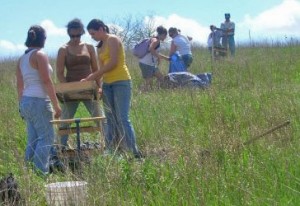Archaeology students examine clues from ancient inhabitants of Iowa
During Intro to Archaeological Field Methods, students gain firsthand insight into Iowa’s original inhabitants — one scoop of earth at a time.
 Iowa State Archaeologist John Doershuk leads the course and focuses on building basic field research skills during their three weeks outdoors, beginning with learning to map and assess the complex terrain of their sites along the bluffs of the Cedar River valley near Mount Vernon. Students also further the investigation of previous digs that proved rich in artifacts of human activity from long ago — they sample the soil in precise sections and layers, filter the soil for artifacts, and carefully record their findings.”It’s definitely hard work,” said Montell Edgar, who took the course in 2009. “You’re lifting augers full of wet clay and sand into sifting trays, then shaking them and intermittently pushing the soil through with your hands. But when you find your first chert flake or piece pottery from 2000 years ago, it makes it all worth it.”
Iowa State Archaeologist John Doershuk leads the course and focuses on building basic field research skills during their three weeks outdoors, beginning with learning to map and assess the complex terrain of their sites along the bluffs of the Cedar River valley near Mount Vernon. Students also further the investigation of previous digs that proved rich in artifacts of human activity from long ago — they sample the soil in precise sections and layers, filter the soil for artifacts, and carefully record their findings.”It’s definitely hard work,” said Montell Edgar, who took the course in 2009. “You’re lifting augers full of wet clay and sand into sifting trays, then shaking them and intermittently pushing the soil through with your hands. But when you find your first chert flake or piece pottery from 2000 years ago, it makes it all worth it.”
A few students, such as Edgar, follow up their work in the field with time in Doershuk’s research lab. Working with the materials collected during class, Edgar spent a summer assisting with preparation of the artifacts for permanent curation. Edgar also participated on another dig at Lake Darling and helped process a donation of artifacts made to the Office of the State Archaeologist.
“While I was working on the donation I found a Cherokee point in the collection that I, with the help of the professionals around me, dated to around 8400 BP (before present), which is an amazing feeling,” Edgar said. “I’ve always planned to go into Egyptology, but working with John made me realize how amazing Iowa’s history actually is.”



